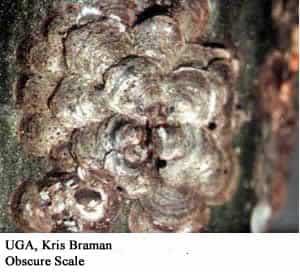 Description: Obscure scale is a key pest of oak but will also attack a wide variety of other trees such as hickory, walnut, maple, willow, beech and dogwood. This insect is not a pest of these trees when they are growing in the forest. It occurs in urban settings, usually on stressed trees.
This pest overwinters as nymphs on host twigs and branches. Females lay eggs from June into August with peak crawler activity occurring in mid-July. This long period of activity makes control difficult and usually requires multiple spray treatments. Early hatched crawlers usually settle beneath the waxy cover of dead scales to feed, while those that hatch later usually seek uninfested areas. The second stage of this pest secretes a protective waxy cover over its body during early fall.
Symptoms: Infestations are most easily recognized by layers of dead dingy colored scales encrusting the branches. The dirty gray wax covers of the females, about 1/8 inch in diameter, blend in with the bark. They often have a black cap that is slightly off center as well. Layers of these scales can build up over time. The waxy coverings can easily be scraped from the bark of branches that are several years old.
Obscure scale removes plant fluid from twigs and branches with piercing-sucking mouthparts. This causes the infested host to drop leaves prematurely and dieback. Numerous sunken areas appear on the back where it feeds and gives a roughened appearance. Infested branches appear to be sprinkled with wood ashes or small pieces of silver glitter. In the case of small trees, their trunks and branches can be disfigured due to a severe infestation.
Action: Early detection of an infected tree is critical for effective management. Monitoring is the first tool that should be used. Prune heavily infested limbs to reduce the spread of this pest. Effective pesticide use is used when this scale is in the crawler stage, and yet unprotected by the waxy cover.
Scales tend to thrive on stressed plants. By following a recommended fertility and water schedule you can promote plant health. Be careful not to over-fertilize, this favors scale buildup.
Thank you for reviewing this information. Schneider Tree Care is committed to preserving and enhancing the quality of your property through tree care education and services. We employ professionally trained and certified arborists who are available to meet with you for a consultation at no charge. If you have any questions or need additional information regarding the health of your trees, please contact us.
Description: Obscure scale is a key pest of oak but will also attack a wide variety of other trees such as hickory, walnut, maple, willow, beech and dogwood. This insect is not a pest of these trees when they are growing in the forest. It occurs in urban settings, usually on stressed trees.
This pest overwinters as nymphs on host twigs and branches. Females lay eggs from June into August with peak crawler activity occurring in mid-July. This long period of activity makes control difficult and usually requires multiple spray treatments. Early hatched crawlers usually settle beneath the waxy cover of dead scales to feed, while those that hatch later usually seek uninfested areas. The second stage of this pest secretes a protective waxy cover over its body during early fall.
Symptoms: Infestations are most easily recognized by layers of dead dingy colored scales encrusting the branches. The dirty gray wax covers of the females, about 1/8 inch in diameter, blend in with the bark. They often have a black cap that is slightly off center as well. Layers of these scales can build up over time. The waxy coverings can easily be scraped from the bark of branches that are several years old.
Obscure scale removes plant fluid from twigs and branches with piercing-sucking mouthparts. This causes the infested host to drop leaves prematurely and dieback. Numerous sunken areas appear on the back where it feeds and gives a roughened appearance. Infested branches appear to be sprinkled with wood ashes or small pieces of silver glitter. In the case of small trees, their trunks and branches can be disfigured due to a severe infestation.
Action: Early detection of an infected tree is critical for effective management. Monitoring is the first tool that should be used. Prune heavily infested limbs to reduce the spread of this pest. Effective pesticide use is used when this scale is in the crawler stage, and yet unprotected by the waxy cover.
Scales tend to thrive on stressed plants. By following a recommended fertility and water schedule you can promote plant health. Be careful not to over-fertilize, this favors scale buildup.
Thank you for reviewing this information. Schneider Tree Care is committed to preserving and enhancing the quality of your property through tree care education and services. We employ professionally trained and certified arborists who are available to meet with you for a consultation at no charge. If you have any questions or need additional information regarding the health of your trees, please contact us. 









